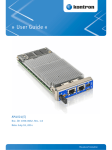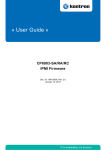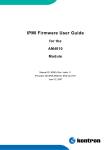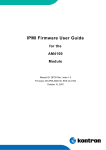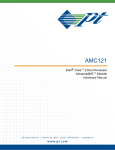Download IPMI Firmware User Guide, Rev. 1.0
Transcript
Chipset, UART LPC IPMI & OEM Signals Chipset, Switches, LEDs etc. IPMI Controller Ethernet Controller SideBand IPMB, HW Monitor, Power Supply, Temp. Sensors, PCIe I²C Serial Port Serial Port Connector IOL/SOL FPGA UART IPMI Firmware Doc. ID: 1055-7522, Rev. 1.0 Date: December 20, 2013 The pulse of innovation DRAFT — FOR INTERNAL USE ONLY » User Guide « User Guide IPMI Firmware Revision Histor y 1.0 Brief Description of Changes Initial issue Date of Issue 20-Dec-2013 Impr int Kontron Europe GmbH may be contacted via the following: MAILING ADDRESS TELEPHONE AND E-MAIL Kontron Europe GmbH Sudetenstraße 7 D - 87600 Kaufbeuren Germany +49 (0) 800-SALESKONTRON [email protected] For further information concerning other Kontron products, please visit our Internet website: www.kontron.com. Disclaimer Copyright © 2013 Kontron AG. All rights reserved. All data is for information purposes only and not guaranteed for legal purposes. Information has been carefully checked and is believed to be accurate; however, no responsibility is assumed for inaccuracies. Kontron and the Kontron logo and all other trademarks or registered trademarks are the property of their respective owners and are recognized. Specifications are subject to change without notice. www.kontron.com 2 DRAFT — FOR INTERNAL USE ONLY Revision User Guide IPMI Fimware Contents Revision History .......................................................................................................... 2 Imprint ..................................................................................................................... 2 Contents .................................................................................................................... 3 1 IPMI Overview ..................................................................................... 5 2 IPMI Controller Configuration ................................................................. 5 2.1 2.1.1 2.1.2 2.2 2.2.1 2.2.2 IPMI in a CompactPCI Chassis.......................................................................... IPMI Firmware Setup..................................................................................... IPMI Setup for the Rack ................................................................................. IPMI in a an MicroTCA/ATCA Environment .......................................................... IPMI in AdvancedMC / AdvancedTCA Environment ................................................ IPMI in a MicroTCA Environment ...................................................................... 3 IPMI Firmware Code .............................................................................. 8 3.1 3.1.1 3.1.2 3.1.3 3.1.3.1 3.1.3.2 3.1.4 3.1.5 3.1.6 IPMI Firmware Code ...................................................................................... 8 Structure and Functionality............................................................................ 8 uEFI BIOS—IPMI Controller Interaction ............................................................. 8 Firmware Upgrade ........................................................................................ 9 Firmware File Formats .................................................................................... 9 Firmware Upgrade via “ipmitool hpm” ............................................................... 9 Firmware Upgrade via “uEFI kIpmi hpm” ........................................................... 10 Firmware Upgrade via “uEFI kUpdate” .............................................................. 11 Setting the SEL Time (CompactPCI) ................................................................. 11 4 FRU Data ........................................................................................... 11 4.1 4.2 4.3 4.4 4.5 Structure and Functionality........................................................................... 11 FRU Version Identification ............................................................................ 11 Board-Specific FRU Data ............................................................................... 12 FRU Data Update ........................................................................................ 12 E-Keying (AMC) .......................................................................................... 12 5 XMC Card Support in a CompactPCI Environment ........................................ 13 6 Hot Swap and Shutdown ....................................................................... 13 6.1 6.1.1 6.1.2 6.2 6.2.1 6.2.2 Hot Swap and Shutdown of a CompactPCI Board ................................................. 13 Hot Swap Handle and Hot Swap LED ................................................................ 13 The Hot Swap and Shutdown Processes ............................................................ 14 Hot Swap and Shutdown of an AMC Module ....................................................... 15 Method 1: The Payload OS Supports ACPI .......................................................... 16 Method 2: The Payload OS Does Not Support ACPI ............................................... 16 www.kontron.com 5 6 6 7 8 8 3 DRAFT — FOR INTERNAL USE ONLY Disclaimer .................................................................................................................. 2 User Guide 7 LAN Functions .................................................................................... 17 7.1 7.2 7.3 7.4 7.5 7.6 7.7 Overview................................................................................................... 17 Setting Up the Ethernet Channel .................................................................... 17 Basic Setup from uEFI Shell ........................................................................... 17 Setup by “ipmitool” or IPMI Commands ............................................................ 18 Setup of User Accounts and Password .............................................................. 18 IPMI Over LAN ............................................................................................ 18 Serial Over LAN .......................................................................................... 19 8 OS Support / Tools ............................................................................... 20 8.1 ipmitool ................................................................................................... 20 9 Terminology and Acronym Definitions ..................................................... 20 10 Related Publications ........................................................................... 21 www.kontron.com 4 DRAFT — FOR INTERNAL USE ONLY IPMI Fimware User Guide IPMI Fimware The Kontron IPMI implementation fully supports the Intelligent Platform Management Interface specification. The IPMI functionality operates under an autonomous management controller even if the board is held in reset or power-down mode by a management card within a system designed for high availability. While the IPMI implementation is fully compliant with IPMI v2.0 and has been designed to operate with any system management software (SMS) that respects this specification, can be easily integrated with the Service Availability Forum — Hardware Platform Interface (SAF HPI) specification. More information about Service Availability can be found on the following website: http://www.saforum.org/ For further information concerning IPMI refer to the following website: http://www.intel.com/design/servers/ipmi/ For board-specific IPMI information, refer to the IPMI chapter of the user guide provided with the CompactPCI board or the AMC module. 2 IPMI Controller Conf iguration 2 .1 I P M I i n a C o mp a c t P C I C h a s s i s IPMI is an extensible and open standard that defines autonomous system monitoring. It is autonomous because every management controller within a CompactPCI chassis monitors its own sensors and sends critical events through a dedicated bus to the BMC that logs it into a non-volatile System Event Log (SEL). The IPMI implementation includes a device SDR repository module that allows the user's system management software to detect all system components and build a database of all management controller sensors. Kontron's IPMI implementation in the CompactPCI environment is compliant with the PICMG 2.9 R1.0 specification. This specification defines the pinout of the J1 and J2 CompactPCI connectors as well as the addressing scheme. Each CompactPCI board is equipped with an IPMI controller acting either as a BMC or as an SMC. There should be only one BMC in the chassis, or at least on the IPMB segment. The BMC may reside either on a board, or on an external system management card, or in a shelf management controller (ShMC). The specification allows all of these variants. As a BMC in the system slot, the board supports dual-ported IPMB (IPMB-0 to the SMCs and IPMB-1 to the external segments via the CompactPCI backplane connector). The BMC administrates the SEL and the SDRR for the complete system. In a CompactPCI chassis, there can be several SMCs. The SMC administrates the sensor and FRU data of the board and makes it available to the BMC. Each SMC can be connected to the BMC via a dedicated bus (IPMB-0). www.kontron.com 5 DRAFT — FOR INTERNAL USE ONLY 1 IPMI Over view User Guide IPMI Fimware Table 1: BMC Mode vs. SMC mode BMC MODE SMC MODE Fixed IPMB address: 20h IPMB address is calculated based on the Geographical Adress System Event Log (SEL) storing all events sent to Events are sent to BMC (20h) via IPMB by default and are also BMC via IPMB stored in the local System Event Log (SEL) Sensor Data Record Repositor y (SDRR) may contain No SDRR all Sensor Data Records (SDR) of all IPMI controllers in the chassis BMC SMC SMC SMC IPMB Address: 20h Fixed IPMB Address: B0h IPMB Address: B2h IPMB Address: B4h IPMB-1 Backplane IPMB-0 IPMB-0 SMC SMC SMC SMC IPMB Address: B6h IPMB Address: B8h IPMB Address: BAh IPMB Address: BCh The IPMB address of the SMCs is determined by the geographic address of the slot. To use the IPMI resources in a CompactPCI system requires an initial setup for IPMI operation. The following actions must first be performed to achieve operable IPMI functionality. 2.1.1 IPMI Firmware Setup To select the BMC or the SMC mode, the kIpmi uEFI Shell command is used. Upon every board reset, the uEFI BIOS forwards the user settings (BMC or SMC mode) to the IPMI controller. The IPMI controller’s factory default setting is SMC mode. 2.1.2 IPMI Setup for the Rack For a working IPMI configuration, the SDRR of the BMC must be filled with all sensor data records of all IPMI controllers in the rack. After every system start the BMC uses the SDRR to initialize all sensors of all boards in the rack. The SDRR setup must be done by a management tool, e.g. the open-source tool “ipmitool”, after system modification. Then the command is: www.kontron.com 6 DRAFT — FOR INTERNAL USE ONLY (GA), e.g. slot number: B0h (slot1), B2h (slot 2), ... BEh (slot 8) User Guide IPMI Fimware ipmitool sdr fill sensors 2.2 I P M I i n a a n M i c roT C A / AT C A E nv i ro n m e n t The Module Management Controller (IPMI controller of an AMC module) is a crucial component of any AMC module. Besides acting as a regular IPMI management controller (sensor monitoring, event logging, etc.), it also provides an interface to all necessary data related to module power requirements and implemented interfaces (E-Keying). Further, it plays an active role in the module hot swap state management. The MMC provides access to various sensors which permit the monitoring of: » System power voltages: +12V (PWR), +3.3V (MP) » AMC module voltages: 5V, +3.3V » Temperatures: CPU and PCH die as well as airflow near AMC edge-connector » Power Good, LAN links, IPMB link, board reset, POST code, boot error, CPU States (processor hot, THERMTRIP, …), IPMB-L state, Health error, IPMI watchdog, etc. Backplane Carrier IPMC AMC AMC AMC AMC AMC AMC IPMB-L Addr.: 72h IPMB-L Addr.: 74h IPMB-L Addr.: 76h IPMB-L Addr.: 78h IPMB-L Addr.: 82h IPMB-L Addr.: 84h AMC AMC AMC AMC AMC AMC IPMB-L Addr.: 7Ah IPMB-L Addr.: 7Ch IPMB-L Addr.: 7Eh IPMB-L Addr.: 80h IPMB-L Addr.: 88h IPMB-L Addr.: 86h (ATCA/ AMC.0) IPMB-L IPMB-L Addr.: 20h IPMB-L Carrier Manager (MicroTCA, active MCH) The IPMB-L address of the AMC modules is determined by the geographic address of the slot. www.kontron.com 7 DRAFT — FOR INTERNAL USE ONLY This will only work if the IPMI controller configured as BMC is addressed. This addressing is the default if the “ipmitool” is running on the payload side of the board where the BMC is residing. User Guide IPMI Fimware The IPMI Controller of the carrier (Carrier IPMC) communicates with the MMC using the local IPMB (IPMB-L) bus. In an ATCA/AMC environment, it is the Carrier IPMC that actually turns on/off the module (payload) power. However, before the Carrier IPMC enables the module payload power, various criteria must be satisfied by both the carrier and the module, including power requirements and capabilities, matching interfaces, current module hot swap state, and any other special conditions as specified by the Shelf Manager policy. 2.2.2 IPMI in a MicroTC A Environment The first element of a MicroTCA Controller Hub (MCH) is its MicroTCA Carrier Management Controller (MCMC) with its carrier manager function as the central authority in a MicroTCA carrier to monitor and control the AMC modules. The Carrier Manager function makes use of IPMB-L links to each AMC, as well as presence detect, module, and power enable signals. The MicroTCA shelf manager also monitors events and controlls the cooling units. 3 IPMI Firmware Code 3 .1 I P M I F ir mw a re C o d e 3.1.1 Structure and Functionality The IPMI firmware code is organized into a boot code and an operational code, both of which are stored in a flash device. Upon an IPMI controller reset, the IPMI controller first executes the boot code which: » Performs a self-test to verify the status of the IPMI controller's hardware including its memory, and » Calculates a checksum of the operational code. After successful verification of the operational code checksum, the firmware will execute the operational code. Only the operational code is upgradable in the field. 3.1.2 uEFI BIOS—IPMI Controller Interaction For communication between the uEFI BIOS and the IPMI controller, the KCS interface is used. During the boot process, the uEFI BIOS sends various IPMI commands to the IPMI controller, such as: » An OEM command which reports the version of the uEFI BIOS » An OEM command which reports the operational status of the uEFI BIOS » The standard IPMI command Set Watchdog Timer to stop a possibly running IPMI watchdog timer » The standard IPMI command Set SEL Time to set the event log time to the time which is kept by the RTC (CompactPCI) » The standard IPMI command Set ACPI Power State to set the state ACPI legacy on (CompactPCI) www.kontron.com 8 DRAFT — FOR INTERNAL USE ONLY 2.2.1 IPMI in AdvancedMC / AdvancedTC A Environment User Guide IPMI Fimware 3.1.3 Firmware Upgrade For local or remote firmware upgrade, the following IPMI interfaces are available: » KCS (locally, requires active payload, but fast) » IPMB (remote, independent of the payload state) » LAN (remote, via IOL, requires also active payload) During the download process, the currently running operational code operates as usual until the activation command is issued. During the activation process, the IPMI controller is off-line for about 20 seconds while the boot code is reorganizing the firmware storage. Afterwards, it starts the new operational code. If this doesn't succeed, after a timeout the boot code performs an automatic rollback to the “last known good” operational code. 3.1.3.1 Firmware File Formats Firmware images for upgrade are provided in the following format: » Firmware images in the PICMG defined HPM.1 file format, e.g. FW-IPMI-<BOARD>-<REL>-FWUM.hpm, for usage with “ipmitool hpm ..” commands. where: <BOARD>identifies the board family of the IPMI firmware (e.g. B400h for the CP6005) <REL>identifies the release (version) of the IPMI firmware. 3.1.3.2 Firmware Upgrade via “ipmitool hpm” Firmware upgrade using an HPM.1 file requires at least “ipmitool” version 1.8.10. The firmware upgrade procedure starts with downloading the HPM.1 file using, for example, the following command: ipmitool hpm upgrade <HPM.1_FWFile>.hpm The next step is the activation of the newly downloaded IPMI firmware. This is done using: ipmitool hpm activate Detailed information about the currently active firmware versions or the redundant copies can be obtained using the commands mentioned below. www.kontron.com 9 DRAFT — FOR INTERNAL USE ONLY The IPMI's operational code can be upgraded via the open-source tool “ipmitool” or via uEFI BIOS commands. The upgrade tool/commands allow download and activation of new operational code and also rollback to the “last known good” operational code. Additionally, the status and the firmware version of the redundant firmware copies can be checked. User Guide IPMI Fimware To obtain detailed version information of the active IPMI firmware, use the following command: To obtain the version of the rollback copy (only valid if a newly downloaded firmware is already activated), use the following command: ipmitool hpm compprop 1 3 To obtain the version of the newly downloaded IPMI firmware (only valid after download and before activation), use the following command: ipmitool hpm compprop 1 4 To obtain detailed information about the IPMI HPM.1 upgrade capabilities, use the following command: ipmitool hpm targetcap To perform a manual rollback to the previously good firmware image, use the following command: ipmitool hpm rollback 3.1.4 Firmware Upgrade via “uEFI kIpmi hpm” The new IPMI firmware must be available from the uEFI Shell using, for example, a USB flash drive. The firmware upgrade procedure starts with downloading the HPM.1 file using, for example, the following command: fs0:\<path>> kIpmi hpm upgrade <HPM.1_FWFILE>.hpm After successful download, the new IPMI firmware is automatically activated. Information about the currently active firmware versions of the rollback firmware version copies can be obtained using the command: fs0:\<path>> kIpmi info Version information of the HPM.1 file can be obtained via the following command: fs0:\<path>> kIpmi hpm info <HPM.1_FWFILE>.hpm To perform a manual rollback to the previously good firmware image, use the following command: fs0:\<path>> kIpmi hpm rollback www.kontron.com 10 DRAFT — FOR INTERNAL USE ONLY ipmitool hpm compprop 1 1 User Guide IPMI Fimware 3.1.5 Firmware Upgrade via “uEFI kUpdate” The update procedure via is performed via the kUpdate -u uEFI Shell command. To select a specific firmware image from the ZIP archive, the kUpdate -s uEFI Shell command is used. When using the kUpdate command, the structure of ZIP archive must not be altered. To perform automatic upgrade during boot-up, use the kBoardConfig AutoUpdate uEFI Shell command. For further information on the uEFI Shell commands, refer to the uEFI BIOS chapter in the respective manual. 3.1.6 Setting the SEL Time (CompactPCI) The IPMI controller does not have its own hardware real-time clock. Therefore, after start-up, restart or upgrade of the IPMI controller, its software clock first must be supplied with the current time. The IPMI controller uses the time when handling event messages which otherwise will have an out-of-date time stamp. Every time when the uEFI BIOS starts up, it supplies the IPMI controller with the payload’s current time. Restarts of the IPMI controller without a following uEFI BIOS reboot will result in invalid date and time indication e.g. after a firmware upgrade. In order to apply correct timestamps to the SEL records, issue the IPMI command Set SEL Time. This may be done by application software on the payload side via the KCS interface or by a remote IPMI controller via the IPMB-0. 4 FRU Data 4 .1 St r u c t u re a n d Fu n c t i o n a l i t y The FRU data contains information about the board such as the part number and the serial number. See PICMG Specification 2.9 for complete details on the FRU data structure. The IPMI controller provides 4 kB non-volatile storage space for FRU information. For further information regarding the FRU data, refer to IPMI — Platform Management FRU Information Storage Definition v1.0, Document Revision 1.1. Full low-level access to read or write the board's FRU Information is provided by regular IPMI FRU Device commands. Care must be taken when writing FRU information directly using standard IPMI commands. Invalid FRU information may disturb a shelf management software which uses the FRU data. 4.2 F RU Ve r s i o n I d e n t i f i c a t i o n The FRU data fields, as defined in the IPMI specification, are used to record the version of the FRU installed. The revision number is incremented for each new release of FRU data. www.kontron.com 11 DRAFT — FOR INTERNAL USE ONLY Firmware updates are typically delivered on a ZIP archive containing only the firmware images. The content of the archive with the directory structure must be copied on a data storage device with FAT partition. User Guide IPMI Fimware Example of board FRU ID: “STD_R10” Example of product FRU ID: “STD_R10” B o a r d - S p e c i f i c F RU D a t a The following FRU data areas and data fields are provided: FRU Board Info Area » Manufacturing date / time » Board manufacturer(C7): “Kontron” » Board Product Name(C6): “CPxxxx” or “AMxxxx” 1) » Board Serial Number(CF): “123456789012345” 1) » Board Part Number(C9): “1234-5678” 1) » FRU File ID(C7): “STD_R10”1) FRU Product Info Area » Product manufacturer(C7): “Kontron” » Product Name(C6): “CPxxxx” or “AMxxxx” 1) » Product Part Number(C2): “00” 1) » Product Version(D9): “0000000000000000000000000” 2) » Product Serial Number(D9): “0000000000000000000000000” 2) » Asset Tag(D9): “_________________________” 2) » FRU File ID(C7): “STD_R10”1) » CustomData(D5): “MAC=CC:CC:CC:CC:CC:CC” 1) 1) Example value / field will be modified during the manufacturing process. 2) Field is free for user. Please note that changes need special care (checksums). 4.4 F RU D a t a Up d a te Typically, an update of the FRU data is not necessary because the board’s correct FRU data is installed at the factory. If an update of the FRU data is required, it can be done via regular IPMI FRU device commands. The correct FRU data must be prepared at the factory. Please contact Kontron for further assistance. 4.5 E-Keying (AMC) E-Keying has been defined in the AMC.0 R2.0 Specification to prevent module damage, prevent malfunction, and verify bay connection compatibility. Therefore, the FRU data of an AMC module contains PICMG-defined records which describe the module’s AMC interoperability: » Module Current Requirements Record » Clock Configuration Record, for the PCI Express reference clock and Telecom clocks » AMC Point-to-point Record, describing module’s AMC port capabilities www.kontron.com 12 DRAFT — FOR INTERNAL USE ONLY 4.3 User Guide IPMI Fimware The respective DIP Switch on the AMC module can be used to forcibly disable some AMC ports and to configure the PCI Express reference clock if required. Please refer to the AMC module’s user guide for further information. 5 XMC Card Suppor t in a CompactPCI Environment The presence or absence of an XMC card is reported by the “XMC present” IPMI sensor. If an XMC card is present, the card's FRU data EEPROM is readable/writable. The size of the EEPROM must be smaller or equal to 256 bytes because of 8-bit EEPROM addressing. Please note that the XMC FRU size is always reported as 256 bytes and writing to locations that are higher than the real capacity should be avoided. The FRU data of the XMC card can be read under Linux using ipmitool fru print 1. 6 Hot Swap and Shutdown 6 .1 H o t S wa p a n d S h u t d ow n o f a C o mp a c t P C I B o a r d 6.1.1 Hot Swap Handle and Hot Swap LED To perform the actions required for hot swapping of the board, a hot swap state machine with the following M-states generated by the IPMI controller is used: » M0:Board Not Installed » M1:Board Inactive » M2:Board Activation Request » M3:Board Activation in Progress » M4:Board Active » M5:Board Deactivation Request » M6:Board Deactivation in Progress For further information of the hot swap state machine, please refer to the PICMG® AMC.0 R2.0, Advanced Mezzanine Card Base Specification, Chapter 3.6. The blue Hot Swap LED (HS LED) of an inserted board in a powered rack is normally used to indicate the board's operational status so as to facilitate hot-swapping of the board: » Hot Swap LED On The payload is inactive: » The board may be activated by closing the hot swap handle, or » The board may be extracted. The M-state is 1. www.kontron.com 13 DRAFT — FOR INTERNAL USE ONLY The IPMI commands Set AMC Port State and Get AMC Port State defined by the AMC.0 specification are used by the carrier or MCH for either granting or rejecting the E-keys (i.e. enabling or disabling of AMC ports during E-Keying). User Guide IPMI Fimware » » When the payload power is off e.g. after a shutdown via an IPMI chassis command and the handle is still closed, the M-state is 1. Hot Swap LED Blinking The M-state is 2, 5 or 6. Do not extract the board and do not actuate the hot swap handle during these states. Blinking pattern: » » long on, short off: the IPMI firmware is in M-state 2 and starts the payload » long off, short on: the IPMI firmware is in M-state 5 or 6 and shuts down the payload. Wait until the HS LED stops blinking and remains on to extract the board. Hot Swap LED Off The payload is active. Don't extract the board now. Normally the extraction is impossible because the hot swap handle is closed and locked. The M-state is 3 or 4. Normally the logical states “active” and “inactive” of a payload are identical to the physical states “handle open” and “handle closed” or “payload power off” and “payload power on”. If, however, the power is switched on or off using IPMI chassis commands or the payload is shut down by the OS, then the position of the hot swap handle and the power state may become asynchronous. In this case the blue HS LED is switched on indicating that the payload power is switched off although the handle is closed. Such actions are not part of the hot swap process and are governed by their own functionality which is not within the scope of this document. 6.1.2 The Hot Swap and Shutdown Processes Hot swap, as defined here, is the purposely initiated process to remove and replace an active board in a powered system. To accomplish this requires that the hot swap process provides for an orderly transition of the payload from the active to inactive state and vice versa. This is necessary to preclude improper system operation and possible loss of data. The board has all the necessary features including hardware and IPMI software to support hot swapping. On the software side, however, not all available OSs support hot swapping, not even partially. Three possible cases for hot swapping based on OS capabilities are described as follows. Case 1: Involves an OS which does not support ACPI After payload power-on, the starting uEFI BIOS will inform the IPMI controller by sending the IPMI command Set ACPI Power State / Set Legacy on. If no further Set ACPI Power State commands are sent and the hot swap handle is opened, the IPMI controller will immediately disable the payload power. In this event, the application/operator is responsible for the termination of all payload processes prior to opening the hot swap handle and initiating removal/replacement of the board to avoid improper operation or loss of data. www.kontron.com 14 DRAFT — FOR INTERNAL USE ONLY Changing from active state to inactive state or vice versa. User Guide IPMI Fimware Case 2: Involves an OS which emulates ACPI support After start-up, such an OS must manipulate the chipset in a way that prevents an immediate power-off when the “power button” is logically activated. Then it must send the IPMI command Set ACPI Power State / S0/G0 working to the IPMI controller to enable this to process later on an S3/G2 soft off command. During application operation the system must cyclically read the “Hot Swap Sensor” (sensor #0) using the IPMI command Get Sensor Reading. This allows the tracking of the board's state. After the board has once reached M-state 4 (sensor reading is 10h) the leaving of this announces that the handle was opened. Now the time has come to terminate all processes. After all critical processes have been terminated, the OS must send the IPMI command Set ACPI Power State / S3/G2 soft off to the IPMI controller which will set the power off immediately. Case 3: Involves an OS which supports ACPI When an OS is started which supports ACPI, the IPMI command Set ACPI Power State / S0/ G0 working is sent to the IPMI controller. This indicates that the OS has reprogrammed the chipset in such a manner that a “power button” signal does not lead to an immediate power-off but only causes an event that can be detected by the OS. When the handle is opened, the IPMI controller asserts the “power button” signal to notify the OS. The OS then shuts down all processes and afterwards causes the transmission of the IPMI command Set ACPI Power State / S3/G2 soft off to the IPMI controller which then switches the power off. 6.2 H o t S w ap a n d S h u t d ow n o f a n A M C M o d u l e As a hot-swappable field replaceable unit (FRU), the board also follows the same stringent carrier grade RASM feature set, namely — Reliability, Availability, Serviceability, Maintainability. When offered in combination with AdvancedTCA platforms, TEM (Telecom Equipment Manufacturers) clients literally conserve valuable system AdvancedTCA system slots. The board supports full hot swap capability as per PICMG 3.0. It can be removed from or installed in the system while it is on (without powering down the system). Please refer to the PICMG 3.0 specification for additional details. During hot swap of a working module, the payload side has to be shut down automatically on command of the MMC and the end of shutdown has to be signalled back to the MMC. Because the board supports ACPI, an OS on the payload side which supports this too makes shutdown very easy. If the OS doesn't support ACPI, there is a special method to be used. www.kontron.com 15 DRAFT — FOR INTERNAL USE ONLY An OS which does not really support ACPI, such as VxWorks, is able to obtain “Graceful Shutdown” support from the IPMI controller by performing in the following way. User Guide IPMI Fimware 6.2.1 Method 1: The Payload OS Suppor ts ACPI » The ACPI daemon must be active. » An ACPI power button event must result in a system shutdown. Hot swap operation sequence processed by MMC and OS: » On command of the carrier controller, the MMC simulates the pressing and release of the power button to force an ACPI event. » The ACPI daemon detects this ACPI event and initiates the shutdown of the payload software system. » At the end of the shutdown, the payload hardware system reports the sleep state to the MMC by setting the appropriate signal line. » The MMC detects the sleep state and reports this to the carrier controller (“quiesced”) so that the hot swap processing can be continued and finished. By default the MMC waits endlessly for the sleep state. Please note that some shelf managers or MCHs use a timeout to simply switch off a module which needs too much time to reach sleep state. As this might be an undesirable situation, refer to the appropriate manual for further assistance. In any event, if an endless wait is to be avoided, it is possible to set a timeout time for the module's MMC after which the system will be switched off unconditionally. For the setting of the timeout refer to refer to the IPMI Chapter of the AMC module’s user guide. 6.2.2 Method 2: The Payload OS Does Not Suppor t ACPI Requirements: » At system start on the payload side, the Kontron shutdown daemon “grnsd” must be started. It is included in the Linux board support packages for the board. This daemon communicates cyclically with the MMC for the exchange of states, commands and acknowledges. For this, it uses the OEM Module Quiescence Feedback command. In principle, it plays the same role as the ACPI daemon of Method 1 above. Hot swap operation sequence processed by MMC and OS: » On command of the carrier controller the MMC sets a “shut down request” flag. » The “grnsd” daemon recognizes this request in the response to its cyclical OEM Module Quiescence Feedback command and initiates the shutdown of the payload software system. » At the end of the shutdown process, the “grnsd” daemon informs the MMC by setting the appropriate flag when calling the OEM Module Quiescence Feedback command. » The MMC reports this to the carrier controller so that the hot swap processing can be continued and finished. www.kontron.com 16 DRAFT — FOR INTERNAL USE ONLY Requirements: User Guide IPMI Fimware By default the MMC waits endlessly for this information. If an endless wait is to be avoided, it is possible to set a timeout time after which the system will be switched off unconditionally. For the setting of the timeout refer to the IPMI Chapter of the AMC module’s user guide. 7.1 O ve r v i ew The IPMI controller supports IPMI over LAN (IOL) and Serial over LAN (SOL). Common for both types of communication is the use of the RMCP / RMCP+ protocol for the packing of the data to be transferred. The RMCP/RMCP+ protocol uses the TCP port 623 by default. While IOL serves to transport IPMI commands and their responses via Gigabit Ethernet, SOL serves to transport any serial data via Gigabit Ethernet. In each case, the IPMI controller serves as a protocol encoder and decoder. IOL is able to use both RMCP and RMCP+ protocols. SOL works only with the RMCP+ protocol. Please note that IOL and SOL need the Ethernet device to be powered. Therefore, the board (payload) must be fully powered. For information on IOL/SOL support, refer to the user guide provided with the CompactPCI board/AMC module. 7.2 S e t t i n g Up th e E th e r n e t C h a n n e l There are two methods to configure the LAN settings (IOL/SOL) for the Ethernet channels: » By use of the kIpmi net uEFI Shell command in the uEFI BIOS » By use of the open-source tool “ipmitool” or IPMI commands The setup methods are compatible, i.e. both methods show the parameters which are set by the other one. When the MAC addresses are set, the ones which are programmed into the hardware must be re-used. This is a restriction. The IP addresses of a channel being used by “normal” payload traffic and IOL/SOL traffic may differ but need not differ as long as port 623 is not used in parallel by payload and IOL/SOL. 7.3 B a s i c S e t u p f ro m u E F I S h e l l With the kIpmi net command from the uEFI Shell some basic settings such as IP address, sub-net mask and gateway address can be set up for the Ethernet channels. www.kontron.com 17 DRAFT — FOR INTERNAL USE ONLY 7 LAN Functions User Guide IPMI Fimware 7.4 S e t u p by “ i p m i to o l ” o r I P M I C o m m a n d s The open-source tool “ipmitool” offers commands for the setup of the Ethernet channels. All possible options are shown by issuing: If “ipmitool” is not usable, the LAN parameters can be set by using standard IPMI commands as defined in the IPMI specification. To show the current LAN parameters for a channel, “ipmitool” offers the command: ipmitool lan print <channel> 7.5 S e t u p o f U s e r Acc o u n t s a n d Pa s s wo r d The open-source tool “ipmitool” offers commands for the listing and manipulation of user accounts for the SOL/IOL channels. An overview can be obtained by issuing: ipmitool user The predefined user accounts for a channel can be listed using the following command: ipmitool user list <channel> For every channel, the firmware has these predefinitions in non-volatile memory: ID 1 2 Name admin Callin false false Link Auth true true IPMI Msg true true Channel Priv Limit USER ADMINISTRATOR Please note that the ADMINISTRATOR password is preset with admin. Changed accounts and passwords stay valid after payload power-off. The accounts must be activated using the following command: ipmitool user enable <user number> 7.6 I P M I O ve r L A N IPMI over LAN (IOL) is used to allow the IPMI controller to communicate with the IPMI controller via LAN using the RMCP or the RMCP+ protocol. The data transferred are IPMI commands and the responses to them. www.kontron.com 18 DRAFT — FOR INTERNAL USE ONLY ipmitool lan set User Guide IPMI Fimware To enable LAN support after parameter setup the following command must be issued: ipmitool lan set <channel> access on The open-source tool “ipmitool” can serve as a control program and user interface for this. “ipmitool” allows the issuing of generic IPMI commands such as: ipmitool -I lan -H 192.168.3.189 -U admin -P admin -A PASSWORD raw 6 1 or to call complex functions like “mc info”: ipmitool -I lan -H 192.168.3.189 -U admin -P admin -A PASSWORD mc info This uses many generic IPMI commands to get the information needed. 7.7 S e r i a l O ve r L A N Serial over LAN (SOL) connects the COM1 or /dev/ttyS0 respectively of the board's payload side to an Ethernet channel. The IPMI controller resides between this serial interface and one of the Ethernet channels. It serves as an encoder and a decoder for the RMCP+ protocol used and controls the data stream. Outside the CompactPCI board/AMC module, for example, the open-source tool “ipmitool” can be used to drive the SOL session, i.e. it offers a console function to communicate via Ethernet with the board’s serial interface. The IPMI firmware supports only “straight password authentication” SOL sessions with default privilege level USER. Opening an SOL session requires special parameters as shown below: ipmitool -I lanplus -H 192.168.3.189 -U admin -P admin -L USER -C 0 sol activate The serial interface can be used as a connection, for example: » to a user program on the board’s payload » to the uEFI BIOS. Refer to the Main Setup menu, Console Redirection function in the uEFI BIOS chapter of the respective User Guide for further information. The serial parameters can be set via this function. » to a Linux login console. This can be activated after payload start, for example, by the command: getty -h 115200 /dev/ttyS0 www.kontron.com 19 DRAFT — FOR INTERNAL USE ONLY Please note that the following commands must use the IP address which belongs to the enabled channel. User Guide IPMI Fimware SOL supports and requires serial hardware handshake. This should be activated for the serial port. Otherwise the transmitted data might get lost. In any case the same serial parameters for the payload side serial interface and the IPMI controller's serial interface must be used. ipmitool sol set This command shows all options that can be set. Further options are listed after issuing the following command: ipmitool sol help 8 OS Suppor t / Tools 8 .1 i p m i to o l A very useful all-in-one Linux tool is “ipmitool” (http://ipmitool.sourceforge.net ). It provides a userfriendly interface to many IPMI features and extensions, for example, to get sensor readings, change sensor thresholds or to access other IPMI controllers via IPMB. 9 Terminology and Acronym Def initions The following table provides descriptions for terms and acronyms used in this guide. The descriptions are derived primarily from the IPMI specifications. Table 2: Terminology and Acronym Definitions TERM or ACRONYM DESCRIPTION BMC Baseboard Management Controller BSP Board Suppor t Package FRU Field Replaceable Unit FWH Firmware Hub memor y location where a complete uEFI BIOS code is stored I2C Inter-Integrated Circuit IPMB Intelligent Platform Management Bus IPMB-0 Intelligent Platform Management Bus which connects all SMCs with the BMC or the shelf man- IPMI Intelligent Platform Management Interface IOL IPMI over LAN KCS Keyboard Controller Style Interface ager (Interface on the host system payload to communicate with the IPMI controller) MP Management Power (power supply for the IPMI controller) PICMG PCI Industr ial Computer Manufacturer Group PWR Payload Power (power supply for the board) www.kontron.com 20 DRAFT — FOR INTERNAL USE ONLY The parameters for the IPMI controller's serial interface can be set by using the following command: User Guide IPMI Fimware Table 2: Terminology and Acronym Definitions (Continued) TERM or ACRONYM DESCRIPTION SDR Sensor Data Record (data structure that def ines an IPMI sensor) SDRR Sensor Data Record Repositor y SEL System Event Log (located in the BMC and keeps track of all events in the chassis) SMBIOS System Management BIOS SMC Satellite Management Controller SMS System Management Sof tware (designed to run under the OS) SOL Serial over LAN DRAFT — FOR INTERNAL USE ONLY (located in the BMC and may contain all SDRs of the chassis’ boards that are administrated) 10 Related Publications The following publications contain information relating to the Kontron IPMI firmware. Table 3: Related Publications PRODUCT IPMI IPMI PUBLICATION IPMI Specif ication V2.0 IPMI- Platform Management FRU Information Storage Def inition v1.0, Document Revision 1.1 PICMG CompactPCI System Management Specif ication PICMG 2.9 Rev. 1.0 CompactPCI Hot Swap Specification PICMG 2.1 Rev. 2.0 PICMG® AMC.0 R2.0, Advanced Mezzanine Card Base Specif ication, Nov. 15, 2006 CPxxxx /AMxxxx User Guide for the respective product MicroTCA PICMG® MTCA.0 Micro Telecommunications Computing Architecture R1.0 AMC PICMG® AMC.0, Advanced Mezzanine Card Specif ication R2.0 PICMG® AMC.1, PCI Express R2.0 PICMG® AMC.2, Gigabit Ethernet R1.0 PICMG® AMC.3, Storage Interfaces R1.0 www.kontron.com 21 User Guide DRAFT — FOR INTERNAL USE ONLY IPMI Fimware CORPORATE OFFICES Europe, Middle East & Africa North America Asia Pacific Oskar-von-Miller-Str. 1 85386 Eching / Munich Germany Tel.: + 49 (0) 8165 / 77 777 Fax: + 49 (0) 8165 / 77 219 [email protected] 14118 Stowe Drive Poway, CA 92064-7147 USA Tel.: + 1 888 294 4558 Fax: + 1 858 677 0898 [email protected] 17 Building,Block #1, ABP. 188 Southern West 4th Ring Road Beijing 100070, P.R.China Tel.: + 86 10 63751188 Fax: + 86 10 83682438 [email protected] www.kontron.com 22
























